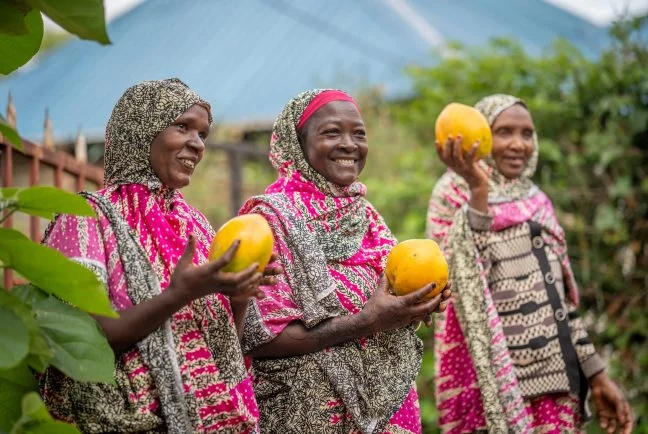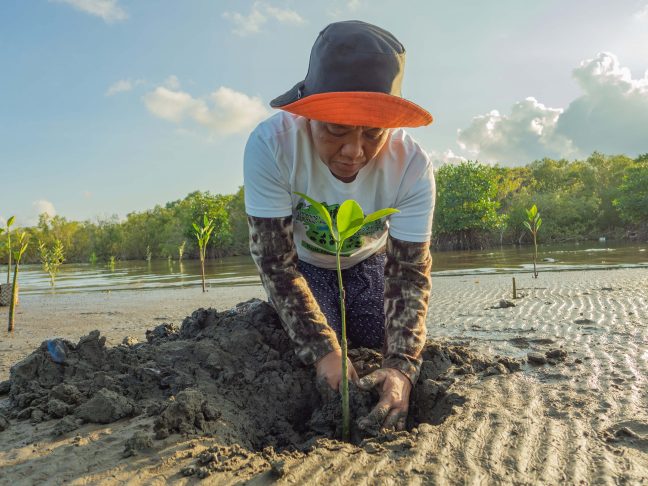How can food security be achieved in the future?
After more than 2 decades Oxfam’s school program has closed. Our commitment to tackling poverty and empowering communities continues. The resources on these pages will no longer be updated.
– September 2019.
Here are five ways that food production and food security can be improved so that perhaps, by 2050, the global demand for 70 per cent more food will in part be met.
In so doing, local communities, in particular small-scale farmers and those farming in challenging environmental situations, will have a better life.
1: Fair Trade
2: Local Food Security Reserves
3: Agroecology
4: Initiatives by and for small-scale farmers
5: Less food wastage
1: Fair Trade
1. Make a list of the Fair Trade products that you can purchase in your supermarket and local shops.
2. Read the Frequently Asked Questions about Fair Trade and produce a poster, video or digital presentation on the purpose of fair trade and the products that it promotes. Think about:
- What is the main aim of Fair Trade?
- How is this achieved?
3. These this case study of small-scale farmers growing coffee in Papua New Guinea use the basis of Fair Trade to improve the livelihoods of the people.
List all the ways the local community benefited once Fair Trade was implemented.
2: Local Food Security Reserves

In the western Africa country of Burkina Faso food security reserves were set up to provide food security when the unpredictable weather conditions reduced food production. Check out this case study and answer the following questions:
1. What is the purpose of a food security reserves for the supply of food and for community livelihoods?
2. Outline how a neighbourhood food security reserve operates for the benefit of small-scale farmers. Include in your answer an explanation of when food is added and when food is distributed.
3. Make a list from the text of what you perceive to be the five most difficult challenges to overcome.
3: Agroecology

Agroecology is the use of ecological processes to design and manage agricultural production and create sustainable farming systems.
Ongoing research and new technologies means that food products can be developed that are best suited to the environment. Making the most of the land and its climate ought to provide more food either for local use or for trade and the return of money to the communities.
System of Rice Intensification (SRI) – an example of agro-ecology in action
SRI is an agro-ecological approach that originally focused on better husbandry of hand-planted rice crops and has since been adapted for other staples. Key components of SRI include starting with fewer, younger, widely spaced seedlings, grown in mostly aerobic soils instead of constantly flooded fields. The resulting larger, healthier root systems give higher yields with 25–50 per cent less water and with fewer inputs such as seeds and less methane gas emissions from paddies.
Oxfam started working on SRI in 2000 and has since expanded its programmes to 12 countries in Asia, West Africa, and Latin America and the Caribbean. As of 2013, over 1.5 million smallholder farmers in groups supported by Oxfam’s partners in Cambodia, Sri Lanka, and Viet Nam had benefited from SRI, using both local and improved varieties of rice.
Widespread adoption of SRI led to increases in yields of 68 percent in Cambodia and 30–50 percent in Sri Lanka in the period 2010–13. In Cambodia, incomes increased by $339 per hectare and in Viet Nam by $200–300 per hectare. In addition, with each season of SRI application the soil ecosystem improves, and along with it potential future crop performance.
The same husbandry principles are applied to new crop rotations, such as potatoes in Viet Nam. Rice straw and stubble are used as a mulch bed which, as it gradually decomposes, improves the soil ecosystem for the next rice crop. Farmers have saved between 28 per cent and 47 per cent in terms of labour, while gaining improvements of between eight per cent and 25 per cent in yields, earning additional income of $480–950 per hectare.
They are also increasingly adopting complementary technologies such as hand-held rotary weeders, which not only improve efficiency but also address concerns over women’s labour. Successful scaling up of these innovations requires an enabling policy environment, particularly in terms of building human capital and empowering communities.
For example, in its national agriculture strategy the Government of Viet Nam has endorsed SRI as a practice that can increase climate resilience. During the period 2010–13, public funds allocated to extend SRI were nearly five times larger than Oxfam’s investment in the six provinces where its programmes were active.
In Ethiopia, the Agriculture Transformation Agency (ATA) is promoting the system of crop intensification for teff. Evidence shows that farmers applying SRI principles have seen yields triple, while also making savings on seed of up to 90 percent.
Source: Oxfam International
1. Use the statistics in this article to create a table to show the benefits of SRI in Cambodia, Vietnam, Sri Lanka and Ethiopia.
2. Producing more rice with less water, using less fertiliser increases yields and incomes and brought change to communities in Mali.
3. In small groups, pretend you are interviewing a Vietnamese farmer who is explaining the changes to food production in his region. One person should be the Vietnamese farmer, another the interviewer, and one could be responsible for recording the ideas. Everyone in the group should contribute to the content design – use the text above as a basis. Record or present your interview so that the class can comment.
4: Initiatives by and for small-scale farmers
In the following two articles, Chandrani’s story from Sri Lanka shows the change that small-scale farmers can experience with improved food security:
Is there a lesson in this story for small-scale farmers elsewhere in the world? Explain your answer.
5: Less food wastage
About one- third of the food produced to eat in Australia ends up as waste. Australians throw away about $8 million in food waste each year. In the developing world, poor food storage post-harvest results in the loss of up to a quarter of the food produced.
Revisit this site and consider the information about waste.
1. What can be done about food waste?
- Grow Challenge – Watch your waste
2. Which of these suggestions on food waste could you implement in your family?
3. Work in groups to design your own campaign to change people’s behaviour on food waste. Discuss what makes an effective campaign. You might like to look at these videos for ideas and inspiration:
- Greenpeace palm oil
- In my place: Oxfam/Coldplay
- Oxfam land grabs for sugar
4. List all the elements that make these videos appealing and interesting to your group – emotions such as determination, optimism, surprise and shock, music, filming and editing.
5. Develop a story board for your own video or marketing campaign to stop people wasting food. Think of the main message you want to develop and how you will best deliver the message. Which music, images and text will you use?
6. Film your message/video. Use video software (e.g. Movie Maker) to develop and edit your message.
7. Organise to show the completed videos at a school assembly.
![Bangladesh: Munni with her daughter. Munni is a tea garden worker and earns just 170 Taka [AU$2.30] per day. She has to take out loans in order to buy groceries and then struggles to pay these loans back. Munni attended training run by Oxfam partner organisation, Breaking the Silence, and says she has gained courage through this training. Photo: Fabeha Monir/Oxfam Bangladesh: Munni with her daughter. Munni is a tea garden worker and earns just 170 Taka [AU$2.30] per day. She has to take out loans in order to buy groceries and then struggles to pay these loans back. Munni attended training run by Oxfam partner organisation, Breaking the Silence, and says she has gained courage through this training. Photo: Fabeha Monir/Oxfam](https://www.oxfam.org.au/wp-content/uploads/2024/08/Oxfam-InuruID-369768-Bangladesh-2024-05-11-22_47_44-1-scaled.jpg)
